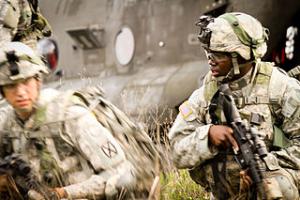AfghanistanU.S. to keep 5,500 troops in Afghanistan beyond January 2017
The United States will keep U.S. troops in Afghanistan beyond next year in response to Taliban advances. President Barack Obama was elected in 2008 promising to end U.S. ground involvement in Afghanistan before leaving office in January 2017, but he now admits that that promise cannot be kept. Obama will later today announce that 5,500 troops will remain in Afghanistan beyond January 2017. The present contingent of 9,800 U.S. troops would remain throughout most of next year, being reduced to 5,500 in 2017.

Members of the 10th Mountain Division set perimeter // Source: commons.wikimedia.com
The United States will keep U.S. troops in Afghanistan beyond next year in response to Taliban advances.
President Barack Obama was elected in 2008 promising to end U.S. ground involvement in Afghanistan before leaving office in January 2017, but he now admits these promise cannot be kept. Obama will later today announce that 5,500 troops will remain in Afghanistan beyond January 2017.
The Washington Post reports that reporters were briefed ahead of the announcement by senior Obama administration officials.
This is the second time the United States has been forced to change its exit strategy in the face of gains by the Taliban. The Islamists now control large swaths of the Afghan countryside.
Defense Secretary Ash Carter, in a speech on Wednesday, indicated that a revision of the withdrawal plan was underway, saying: “The narrative that we’re leaving Afghanistan is self-defeating. We’re not, we can’t and to do so would not be to take advantage of the success we’ve had to date.”
In a speech in the Rise Garden in May 2014, Obama announced it was time to “turn the page” on the costly wars launched by President George W. Bush, and said he would reduce the U.S. military presence to around 1,000 troops, all based in Kabul, by the end of 2016.
That small force would have prevented the U.S. military from advising Afghan forces in combat or conducting counterterrorism operations against al-Qaeda or threats to the homeland. The larger force of 5,500 troops is projected to cost about $15 billion a year, or about $5 billion more than the smaller, 1,000-person Kabul-based force would have cost.
The U.S. hand was forced by the Taliban taking over Kunduz, Afghanistan’s second largest city, which was a major blow to the Afghan government and to the U.S. military.
The Taliban pulled back from Kunduz on Tuesday after occupying the city for two weeks, but the fact that the Afghan army, supported by U.S. Special Forces, could not defend the city was worrisome.
In the background briefing, reporters were told that the present contingent of 9,800 U.S. troops would remain throughout most of next year, being reduced to 5,500 in 2017. The U.S. Special Forces on the ground are engaged in fighting alongside Afghan soldiers, but most of the U.S. troops are engaged in training roles, operating from bases in Kabul and in Kandahar in the south.
The Obama administration has also expressed concern about Islamic State fighters now moving into Afghanistan, drawing recruits from within the Taliban.
Other NATO countries with soldiers in Afghanistan are likely to follow the United States and extend the stay of their own forces.
Obama approved the plan earlier this week. It calls for the U.S. military to retain bases in Kabul, and also have forces at Bagram Air Base and at bases outside Kandahar and Jalalabad, the largest cities in Afghanistan’s southern and eastern regions.
The Post notes that the extended Afghanistan presence could be part of a global network of counterterrorism facilities which, according to a plan developed by Gen. Martin E. Dempsey, former chairman of the Joint Chiefs of Staff, would allow the United States better to manage threats without requiring large conventional forces on the ground.
